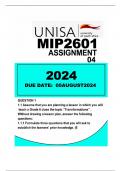,MIP2601 ASSIGNMENT 04 DUE DATE: 5 AUGUST 2024
UNIQUE NUMBER 348743
QUESTION 1
1.1 Assume that you are planning a lesson in which you will teach a Grade 6
class the topic “Transformations”. Without drawing a lesson plan, answer the
following questions:
1.1.1 Formulate three questions that you will ask to establish the learners’ prior
knowledge. (6
1. What do you understand by the term ‘transformation’ in math?
This question aims to gauge if students have a basic understanding of
transformations as it relates to geometry, specifically whether they can articulate
what transformations involve.
2. Can you name any types of transformations you have learned about before?
This question seeks to identify specific terminology or concepts that students
are already familiar with, such as translation, rotation, reflection, or dilation.
3. Can you provide an example of a transformation that you can see in real life?
This question encourages students to connect mathematical concepts to their
everyday experiences, helping to assess their ability to apply their knowledge of
transformations to real-world contexts.
Reference:
- Van Hiele, P. M. (1986). "Structure and Insight: A Theory of Reasoning in
Geometry." This resource discusses the importance of understanding learners'
prior knowledge in geometry, including transformations.
,1.1.2 Describe two activities that you will do with your learners in class (your
activities should cover all aspects of the topic). In your activities, you should
include relevant drawings which will be used in the activities and your step-by-
step explanation of the specific aspect of the topic about which the
activity is. (6)
Activity 1: Plant Growth Simulation
Objective:
To understand the necessary conditions for plant growth, including sunlight,
water, soil, and air.
Step-by-step Explanation:
1. Introduction: Begin the lesson by discussing what plants need to grow. Use a
whiteboard or chart to list these conditions.
2. Materials Needed:
- Plastic cups (to represent pots)
- Soil
- Seeds (e.g., bean seeds)
- Water
- Sources of light (sunlight or desk lamps)
- Drawings: Create a drawing showing a plant with roots, soil, and the sun.
3. Procedure:
- Step 1: Divide the class into groups and give each group a plastic cup, soil, and
seeds.
- Step 2: Each group fills their cup with soil and plants one seed in it.
- Step 3: Water the seed appropriately and place the cup in a designated spot
with adequate sunlight.
- Step 4: Assign different treatments to different groups: some keep their plant
in full sunlight, some in partial sunlight, some in darkness, etc.
, - Step 5: Over the next few weeks, have students observe their plants and
record growth measurements.
4. Conclusion: After the growth period, reconvene to discuss the outcomes based
on sunlight, water, and other treatments. Students can create graphs to represent
their findings.
Activity 2: Food Chains and Ecosystems
Objective:
To illustrate the concept of food chains in an ecosystem.
Step-by-step Explanation:
1. Introduction: Explain the concept of food chains and the roles of producers,
consumers, and decomposers using a simple drawing.
2. Materials Needed:
- Construction paper or chart paper
- Markers
- Pictures or drawings of organisms (e.g., grass, rabbit, fox, mushroom)
- An example food chain diagram.
3. Procedure:
- Step 1: Introduce students to different organisms in an ecosystem and classify
them as producers, primary consumers, secondary consumers, and decomposers.
- Step 2: Provide each student with pictures of different organisms, or have
them draw their own.
- Step 3: Students will work in small groups to create a food chain on their
construction papers. They should illustrate how energy flows from one organism
to another.
- Step 4: Have each group present their food chain and explain the roles of the
different organisms.




